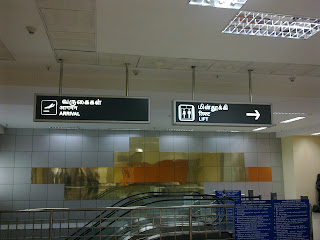In the last post I talked about the confusion apparent in airports and aircrafts of India, and highlighted the confusion that I witnessed in some of our international airports.
I wish to dive deeper to understand the root causes for this confusion in our airports, and unravel what lies beyond this mirage of confusion.
Amidst the fast expanding global liberal markets that have resulted in influences deep into societies across the world, Indian governance machinery appears peculiarly suspicious of the power of market forces, and continues exercising its power by means of regulations, constraints, guidelines and circulars on businesses through complex & innovative combinations of committees, regulatory bodies, departments and sometimes dedicated ministries. One such combination is that of the Airports Authority of India (AAI), Airports Economic Regulatory Authority, Civil Aviation Ministry, and the quintessential Indian flagship - the Department of Official Language.
At the outset, isn't it itself startling that the Rajbhasha department (whoever needs it?) is even listed in the affairs of an authority responsible for Indian airports?! Being a super biased yet powerful department that it is, it is not surprising how this department finds an influential spot in the airways market in India. It is empowered to monitor and influence the deployment of Hindi in AAI, among other central government undertakings. This deployment has incorporated Hindi in examinations and interviews, Hindi literacy is now a key pre-requisite for employment in many of its agencies. These agencies, in turn strive to press indirectly and repeatedly on the AAI and related departments the need for having Hindi in all possible uses of language - the interiors of airports and flights not excluded from this list. As a consequence of such machinery aided by the who-asked-for-it three-language formula we've all become mute evidence to confusion lurking in our public places.
The final casualty of all this is doubtlessly the common man, and the customer in his respective market. It is reasons such as these behind market ill-health that we need to wake up to, not get used to the filthy situation itself. It is the customer inside each of us who can poke businesses to strive to get our markets back to good health. After all how far can one fly with strings attached?
I wish to dive deeper to understand the root causes for this confusion in our airports, and unravel what lies beyond this mirage of confusion.
Amidst the fast expanding global liberal markets that have resulted in influences deep into societies across the world, Indian governance machinery appears peculiarly suspicious of the power of market forces, and continues exercising its power by means of regulations, constraints, guidelines and circulars on businesses through complex & innovative combinations of committees, regulatory bodies, departments and sometimes dedicated ministries. One such combination is that of the Airports Authority of India (AAI), Airports Economic Regulatory Authority, Civil Aviation Ministry, and the quintessential Indian flagship - the Department of Official Language.
At the outset, isn't it itself startling that the Rajbhasha department (whoever needs it?) is even listed in the affairs of an authority responsible for Indian airports?! Being a super biased yet powerful department that it is, it is not surprising how this department finds an influential spot in the airways market in India. It is empowered to monitor and influence the deployment of Hindi in AAI, among other central government undertakings. This deployment has incorporated Hindi in examinations and interviews, Hindi literacy is now a key pre-requisite for employment in many of its agencies. These agencies, in turn strive to press indirectly and repeatedly on the AAI and related departments the need for having Hindi in all possible uses of language - the interiors of airports and flights not excluded from this list. As a consequence of such machinery aided by the who-asked-for-it three-language formula we've all become mute evidence to confusion lurking in our public places.
The final casualty of all this is doubtlessly the common man, and the customer in his respective market. It is reasons such as these behind market ill-health that we need to wake up to, not get used to the filthy situation itself. It is the customer inside each of us who can poke businesses to strive to get our markets back to good health. After all how far can one fly with strings attached?


